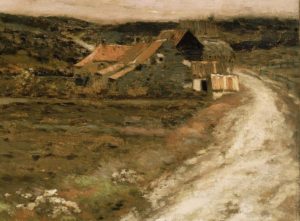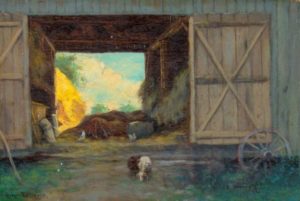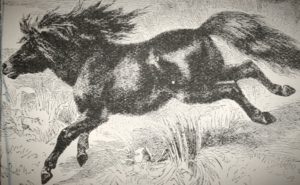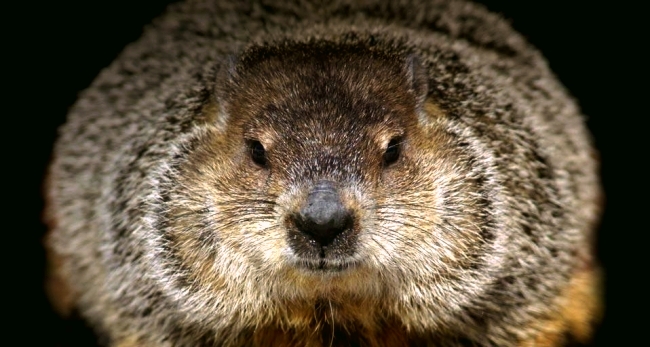A childhood memory, ca. 1965, when I was nine years old in Swannanoa, North Carolina . . . Up in the holler . . .
If my memory serves me correctly, it was late afternoon; I don’t remember what season of the year it was, although it was warm outside.

As I often did in the afternoon, I followed my dad from the house and up to the barn; we started up the narrow farm road that lay between the house and the small creek that flowed from further up the holler. This small creek, the focus of so many hours of play and adventure, ran past the barn, behind the hogpen and the chicken house, descending past the house, where it passed under a bridge at the corner of our front yard and on down the mountain toward the Swannanoa River. We were headed up to the barn to feed the animals and to milk the cow.
Our barn was a magical place. Left to the imagination of a nine-year-old boy, the barn could become a world of its own, and far removed from the isolated hollow in the mountains. The boundaries of my childhood world were largely defined by natural barriers – high ridges that surrounded our small holler on three sides, with the open sky overhead. From within this secluded valley, the world beyond seemed far away. So high were the ridges surrounding our holler that the sun was late to reach the house and the barn, and our fields and gardens in the morning – and early to leave them in the afternoon. The small world of our holler was a place of quiet security, and full of life and adventure.
In the barn lived a mule, a milk cow, one or two calves, our Shetland pony, and the inevitable litter of kittens that scurried in and out of their hiding places. Approaching the barn from our house below, the wooden structure straddled the narrow farm road between a small pasture on the left, and a creek on the right. The gabled apex of the roof towered above the ground below, where the wide entrance to the inside corridor that continued through the barn, separated the stalls on the right side of the barn’s interior from those on the left.

The floor of the stall on the upper side, at the far end of the barn, was almost always wet because the sloping ground from the pasture at the barn’s upper side funneled rainwater into that corner stall. The front opening on the ground floor of the barn was closed by a large, hinged gate-door that swung open from the left. This large gate-door was constructed of rough-cut wood; a vertical series of parallel boards, spaced about five inches apart were attached to a large rectangular frame with interior “Z” that shaped supports. This hinged gate-door formed what looked like a large, wide ladder that covered the front opening of the barn’s corridor when it was shut. There was also a smaller opening into the loft at the front of the barn, above the main entrance. Although we were told not to do so, my siblings, my cousins, and I loved to climb the gate-door at the entrance to the barn, and scramble into the loft. It smelled of hay, and dust, and manure from the stalls below . . . It was a great place to play, and to get in out of the rain in the summer time. There’s something soothing and magical about the sound of rain on a barn roof, while lying in a soft pile of hay in a barn loft; if you’ve ever had that privilege, you know what I mean.
Entering the barn, and immediately to the left, was what we referred to as the “feed-room.” This room had a raised wooden floor two or three steps above the dirt floor. A couple of wooden barrels in the room were filled with mixed grain and feed for the livestock. At the back left corner of the feed room was the landing for the stairs to the barn loft. To this day, I can remember the scent of this room; it was a good smell – like the aroma of molasses and grain, from the feed in the barrels.
But, I’m getting carried away with details, here; back to my story . . .
The unexpected event that occurred at the barn on this particular afternoon, I could have never imagined. As accustomed as I was to visiting the barn, and being in close proximity to the variety of animals and wildlife, I never gave much thought to the interaction between them. As I think back to those days so many years ago, it seemed natural to see the mule and cow together in and around the barn. Most every day, the chickens were turned out of their fenced area to wander around the barn and the house, where they would eat bugs, and seeds, and pick at the ground. We often saw groundhogs (sometimes called whistle-pigs), and squirrels, raccoons, and a wide variety of birds. And, in one way or another, there would be interaction between all of these animals. It was common to see the kittens in the barn, running in and out of the stalls with the livestock. The pony was always curious about the chickens, and often stood close to the cow, or the mule. But I didn’t pay much attention until this particular day . . .
On the far side of the barn, an open area was bordered on the right by the creek that flowed below the barn. The far end of the barn corridor opened onto this small pasture area. About thirty feet from the barn was an old stack of rough-cut lumber that had been there for as long as I could remember. The ground where the lumber was stacked was on a minor slope, and the downhill end of this lumber was supported by a pile of stones to keep it level; this created a small, cave-like opening between the stones and under the stack of lumber.
As Dad and I came out of the barn, we noticed our pony, Champ stood facing the lumber stack’s lower end. He seemed curious about something underneath. As we stood and watched, we heard a sort of high-pitched “chortling” noise. We took a few steps closer to get a better look into the opening underneath the stack of lumber. This sudden noise caused Champ to paw the ground, and he inched closer to the lumber. Champ leaned forward, stretched his neck toward the opening, and sniffed.

Suddenly, he jumped back and made a high-pitched neigh as a bristling groundhog came tearing out of the opening, kicking dirt in front of him as he charged between the pony’s legs, underneath his belly, and started toward the creek. The chortling noise of the groundhog became a loud screech as he raced through Champ’s legs, looking for an escape. The coarse grey and brown hair along the groundhog’s back stood up, and his legs and feet churned the dirt as he ran. Champ stomped at the ground, and spun around as the groundhog tried to make his escape toward the creek.
The sudden hysterical noise and frenzied movement of the groundhog and the pony was terrifying. I froze and didn’t know what to do, but my dad told me to move back into the barn as he stayed between me and the action in the barnyard. I moved back toward the barn, but stayed out in the yard where I could watch the spectacle in front of us.
As Champ whirled around, he squealed and gave chase to the groundhog, stomping the ground after it. Hearing this noise, the groundhog promptly turned to face the pony, head on. Suddenly, the action stopped. The groundhog, puffed-up and hair bristling, stretched up toward Champ as the pony extended his neck to get a close sniff of the agitated whistle-pig. Then time seemed to slow down . . .
The groundhog opened his mouth and showed his teeth; his head and shoulders vibrated as he shrieked and chortled loudly. As they faced each other, noses only a couple of feet apart, Champ’s hair rose along his back, and he inched closer with his nose. As Champ inched closer and closer, the groundhog shrieked louder and advanced on the pony, with his teeth bared. Then, with lightning quick movement, the groundhog lunged forward, and with his mouth, savagely clamped down on the end of Champ’s nose.
Time seemed to speed up and the next few seconds were a hysterical blur . . . Champ’s sudden scream sounded like some tortured demon out of Hell. I was frozen to the ground and could only watch, and hope that neither Dad nor myself would be trampled or bitten.
As Champ screamed, he jerked his head up and away from the groundhog, but as he pulled his head up, the groundhog came up off the ground with it. As Champ’s nose arched toward the sky, the groundhog was carried up and over Champ’s head. At the top of the groundhog’s arch, the chunk of nose in his mouth broke free and blood poured from Champ’s nose. The whistle-pig completed a couple of 360s in the air, over Champ’s back and then landed on the ground behind the pony.
By this time, Dad and I had managed to move back into the relative safety of the barn, but we could still see the action in the pasture. As the groundhog fell to the ground, Champ was slinging his head up and down, back and forth, and screaming furiously as the blood dripped from his butchered nose. His ears were laid back against his head, his eyes rolled wildly, and he began stomping the ground in every direction.

The groundhog quickly got to his feet, got his bearings, and with a bloody face and mouth, headed back toward the creek at a run. But Champ was furious, and gave chase; stomping the ground as the whistle-pig scampered off with a large chunk of his nose.
As vivid as the memory of this event is to me, I do not remember whether or not the groundhog escaped Champ’s wrath. To this day, as I write this, I can still remember the terror of those few seconds after the groundhog chomped down on Champ’s nose . . . It was one of the most memorable moments that I ever spent at the barn with my dad. Over the years, he and I occasionally talked about that afternoon and shared our thoughts about that day.
![]()
In 1990, while in the Navy and stationed as a technical instructor at the Naval Unit on Lowry Air Force Base in Denver, Colorado, I spent a couple of months putting down some of my childhood memories in the form of poetry. It was during that time that I wrote about this event, and only recently decided to put it into a short-story form. The poem below, is from 1990.
Groundhogs and Ponies
The groundhog scampered ‘cross the yard,
and caught the pony’s eye.
The pony tried to sniff him close,
but groundhog, he was sly.
The equine curiosity
to whistle-pig seemed a threat.
As Champ inched close, whistle-pig took aim;
the pony’s nose he bit!
The pony screamed, and backed away
with terror in his eyes.
He jerked his head to rid the pain;
whistle-pig was on the rise.
Over and over thru the air,
as a chunk of nose broke free
As he hit the ground, and gained his feet,
whistle-pig tried to flee!
The pony wheeled to face his foe,
the demon in the yard,
whose mouth did hold his precious nose,
he’d stomp him; stomp him hard!
It’s at this point my mem’ry fails,
the next is lost to me;
whether groundhog got his poor bones crushed,
or scampered off scot-free . . .
Tom Ballard grew up in Western North Carolina near Asheville. From birth to the age of twelve, he lived with his parents, sister, and two brothers in the home of his paternal grandmother, on a small farm at the head of a mountain “holler.” At the age of twelve, his parents bought a house near his mother’s family, north of Weaverville, North Carolina, where he lived until he married in 1975.
The following year, he left North Carolina after joining the U.S. Navy. He retired from the Navy in 1994 and settled with his family in West Virginia. After his service in the Navy, Tom was employed by the Federal Aviation Administration for twelve years, and then the Federal Bureau of Investigation for nine years until he retired in early 2016.
**Featured image “Groundhog” on Wallpapercave.com
